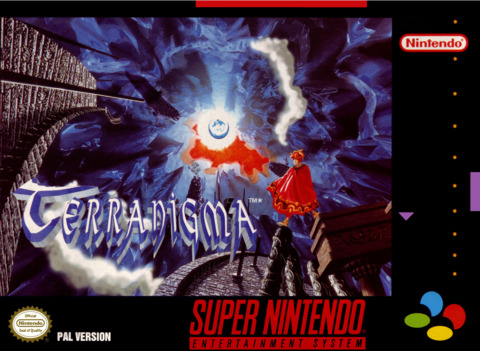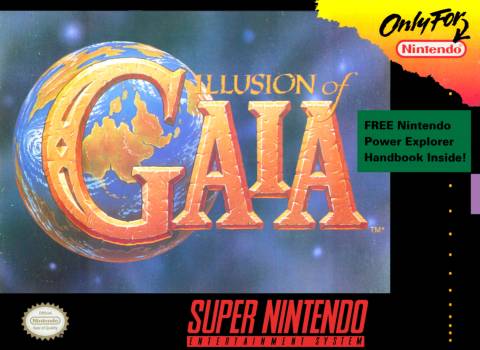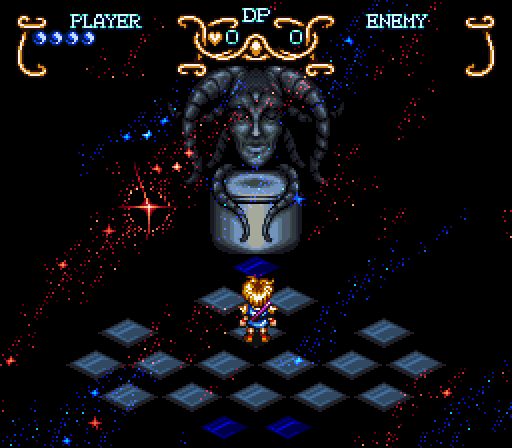The SNES Classic Mk. II: Episode XXIV: Quintet-sential
By Mento 0 Comments
The SNES Classic had a sterling assortment of games from Nintendo's 16-bit star console, but it's hardly all that system has to offer a modern audience. In each installment of this fortnightly feature, I judge two games for their suitability for a Classic successor based on four criteria, with the ultimate goal of assembling another collection of 25 SNES games that not only shine as brightly as those in the first SNES Classic, but have equally stood the test of time. The rules, list of games considered so far, and links to previous episodes can all be found at The SNES Classic Mk II Intro and Contents.
Episode XXIV: Quintet-sential
The Candidate: Quintet's Terranigma

This episode's kind of a special one for me, which is why I saved it for the penultimate entry. I've spoken a few times about my love for the overlooked Quintet, who developed half a dozen of the best SNES games ever made and then more or less vanished when the PlayStation era came around. While ActRaiser has been a long-time favorite and the Robotrek playthrough was more of a burning curiosity I felt I had to slake, Terranigma has been one of the most imposing white whales for the system and is, bar none, the game on my shortlist for this feature that I wanted to tackle the most.
Terranigma is the third of the thematically-linked Soul Blazer trilogy, after Soul Blazer (reviewed here) and Illusion of Gaia (which is reviewed just below), and like those games concerns the resurrection of the planet and its many flora and fauna. However, it's a much more narratively disjointed and contemplative tale compared to its peers, and far more ambitious to boot. While the lofty environmental, societal, and spiritual themes of these games have been their primary connective tissue, there's a certain other throughline that ably demonstrates the evolution this series has seen: the way it plays.
Each game in the Soul Blazer trilogy is loosely built on the structure of The Legend of Zelda with its real-time, top-down combination of action, combat and puzzle-solving. However, the first game was limited in this regard: you had the standard attack swing and a few spells to fall back on. Illusion of Gaia, as we'll speak more on in a moment, added different forms for your character to take which expanded their repertoire to include fireballs, sliding tackles, and a powerful leap attack. Terranigma's hero Ark has even more moves at his disposal depending on the combination of attack, jump, and run you happen to be holding. What's more, these attacks are more effective against specific types of enemies, ensuring that you don't always make a beeline for the most elaborate maneuver in your arsenal and instead mix it up to find the right tools for the job. The game feels far more fluid as a result, and the extra mobility of the leaping and running protagonist also expanded the number of directions that the dungeon design could take.

Whereas Soul Blazer was built like a dungeon-crawler, and Illusion of Gaia like a linear novel, Terranigma defies any easy categorization. There's an inclination early on, in which Ark is travelling to a number of towers full of traps and monsters on every floor, that the rest of the game will be structured the same way. To an extent that's true, but the dungeons and towns and other locations take on many forms as Ark's journey progresses, moving from the straightforward work of resurrecting the continents to fulfilling the requirements to revive the birds, beasts, and people. Once our complicated species is on the scene, the game transforms again, adopting story threads with more in the way of human intrigue, elaborate folklore, and before-their-time mechanics like a town-building sim (it's a strange coincidence that I took a break from building my kingdom in Ni no Kuni II to witness Terranigma's much more inchoate version of the idea). The amorphous nature of the game's narrative means that, while you don't get much of a sense of an overarching narrative beyond Ark's journey to resurrect the Earth, you're never quite sure where the game will go or throw at you next. I started the game wandering an inverted planet and fighting my way through ominous but relatively generic tower dungeons, only to find myself a few hours later in Colorado trying to fill the skies with birds again. At the point I had to pause the game to write this piece, I'm about to enter a haunted castle in Spain to solve the mystery of Christopher Columbus's disappearance. Illusion of Gaia had something of this vignette-nature to its story too, but nothing quite like the shifts in scope and purpose.
Despite somehow bouncing off the game an untold number of times in the past, this time it managed to stick and I'm so glad it did. Terranigma is definitely the magnum opus of Quintet's ludography: a culmination of all the strange narrative choices and strong gameplay and level design that went into all their previous works, and a remarkable paragon of innovation and idiosyncrasy even among the SNES's varied and well-considered RPG library.
That said, a game isn't anything unless the P.O.G.S. have taken a shine to it. Don't look at me: they make the rules now. Please, send whatever help you c- Oh no they're outside! They're slamming down the door somehow!
- Preservation: Though it's never too bad due to the episodic nature of short vignettes, Terranigma does occasionally suffer that old game problem of a lack of clear direction. Some places give you hints via a fortune teller, but they tend to be vague and provide only general goals. Not that the alternative of an ever-present big blinking indicator on the map is necessarily preferable, but the game can screech to a halt at times. Besides that, the controls, pixel art, sound, and the deeply strange story could all find easy purchase in the Steam store today should that ever be an option, and the action gameplay and lack of menu micromanagement means it doesn't drag at all like other SNES JRPGs might. 4.
- Originality: In many regards, Terranigma is building from the foundations set by Soul Blazer and Illusion of Gaia (and ActRaiser, for that matter), but the bizarre goal of completing dungeons to resurrect major elements of the Earth's ecosystem - from nations to animal kingdoms to entire continents - is quite the hook to stick your game's progression on. The acrobatic gameplay is closer to a Castlevania or Mega Man rather than Zelda or any of the system's other action-RPGs. Despite Terrangima's lofty aspirations, there's still a bedrock of smart quality-of-life-enriched game design, from frequent save points to a lack of fail states (beyond starting over the dungeon from the start) to a magic system that has you burn "magirock" at a store to make spells which then revert back to magirock upon use, meaning you always have a decent supply of magic but not in a fixed state where you can abuse it. Terranigma is definitely out there happily being its own weird little thing. 5.
- Gameplay: I don't think I've played a better action-RPG for the SNES. Ys V was a lot of fun, but its trial-and-error magic system left a lot to be desired. Secret of Mana had those weird delays between you hit something and when it registered the damage, and waiting for the attack gauge to refresh made combat more methodical and slow than fluid. Secret of Evermore improved on that, but only very slightly. Zelda's was naturally great and fluid, but it didn't have the level of nuance regarding adjusting for monster types and elements that Terranigma does. Tales of Phantasia came closest, though even that was slowed by the genre-standard battle screen transitions. Terranigma builds from what was already a great top-down combat system in Illusion of Gaia and stands at the top of the heap, as far as I'm concerned. 5.
- Style: Chrono Trigger is rightly heralded as one of the most attractive SNES games ever made, frequently going ham on certain backdrops - the court in Guardia Castle, or the panning shot of Magus's Castle - and adding so much detail to even mundane environments like the kitchens of regular homes. While Terrangima's dungeons are a little less impressive, it still goes for those amazing vistas on occasion, sporting pixel graphics that occasionally look like digitized photos. The Underworld, which also has the best music in an overall fantastic soundtrack, has this amazing inverted Mode 7 effect while moving. The game has some excellent character animations also, especially for its energetic protagonist and his various attacks. While the localization for the European version of the game is a bit stiff in areas, the story still has a compelling nature due to its unpredictability. 5.
Total: 19.
Other Images:
The Nominee: Quintet's Illusion of Gaia

It might seem a bit cruel to follow Terranigma with its less polished but still hardworking older brother. The chips just happened to fall this way due to how I structure these blogs to go with the newly discovered game first. Illusion of Gaia, or Illusion of Time as I know it, is the second in the Soul Blazer trilogy, falling directly between Soul Blazer and Terranigma. However, beyond sharing themes of transforming the world (our world, no less) to its original state, all three have some significant differences.
Illusion of Gaia begins with Will in the town of South Cape. He has designs on a life of adventure, chasing after the specter of his missing explorer father, but a chance meeting with the soul of the very planet puts him on a different but parallel course. Though Will is the only playable character, others filter in and out of the narrative, most notably the local crown princess Kara and her porcine protector Hamlet. Will's friends refuse to let him carry his burden alone either, finding themselves along for the ride. As a group, the game travels across the globe from the Nazca Plains to the Great Wall of China to Cambodia's Angkor Wat temple. Sometimes there's monsters to kill and dungeons to explore, but there's the occasional interlude where you have to solve a mystery, break up a slavery ring, or fulfill a dying man's dream. Illusion of Gaia's big ace in the hole is that it was penned by a genuine sci-fi novel writer, Mariko Ohara, so it doesn't generally conform to a typical RPG story arc.
As with the other two games in the trilogy, Illusion of Gaia's gameplay models itself on The Legend of Zelda series but adds a few RPG mechanics in for flavor - nothing much more than automatic stat boosts earned from eliminating all the monsters in each area, though it makes an appreciable difference in the long-run and is a useful way to ensure you're in fighting condition for the boss (any stat boosts you miss in a dungeon are handed to you after its boss fight, conveniently). Will uses a purple flute as his primary weapon, and eventually learns to use a sliding tackle to damage enemies and get through smaller spaces. He is eventually capable of transforming into two other characters, but only in action areas like dungeons: the warrior Freedan, who has an imposing array of dark magic abilities; and the enigmatic Shadow, a formless entity capable of melting through the ground to the floors below. Though Shadow comes very late into the game, both Will and Freedan learn new skills as the game progresses that expands not only their combat potential but their traversal abilities also, which might lend the game a certain spacewhipper/Zelda feel but for the fact that the game is wholly linear and rarely allows you to return to previous areas (which also handily means that everything in a dungeon is accessible the first time you visit). A particular highlight are the game's boss battles, which can be quite challenging if you don't have the mechanics down pat.

As much as I love Terranigma's soundtrack, I might have to give the "best music" kudos to Illusion of Gaia. In fact, I adore its soundtrack so much I wrote a huge piece on it years ago, going through the songs one by one and describing their effect on my lasting memories of the game, chiefly due to just how atmospheric it all is. Between the story and the affecting soundtrack, Illusion of Time really works itself to the bone to make you care about its central characters, the plights of oppressed peoples around the globe, the cycle of birth and death that governs all life, the underlying and unexplained mysteries of planet Earth and its most famous landmarks, and though the story goes in some insane directions there's a certain transparent purity to the characters and their motivations to help carry you through the more left-field twists. It's sort of like how any Persona game can throw the weirdest, most metaphysical nonsense at you in its final act, but you can weather it because the characters - who you've spent so long with and can relate to - react to these big changes like you'd expect.
It would take more than a 16-bit JRPG with a typically iffy translation before it could reach that point as a medium, perhaps, but Illusion of Gaia was the first game I ever played that convinced me that I could care about little pixellated video game people to the same degree I might about the heroes of a comic book or a movie. Prior to that, all I'd played were western RPGs - the type that usually has you build tabula rasa parties from scratch, which you certainly grow attached to but not in a empathetic sense - and action games that had nary a plot beyond an opening crawl regarding the criminal empire of Mr. Big or an invasion by the evil alien Vectroids. Illusion of Gaia had a genuine story, with genuine emotional moments and a cast you could care about, and that was a revelation to my much younger self.
Illusion of Gaia still means a great deal to me, but if P.O.G.S. should tell me it's awful then who am I to disagree? What is my subjective reality in the face of unflappable (but definitely flippable if you hit the stack just right) science?
- Preservation: It could use a new localization, but what has helped Illusion of Gaia age well are its elaborate character designs (created by a pro mangaka, Moto Hagio), its aforementioned novel-like story, its linear if atypical progression, its thoroughly accessible light action-RPG gameplay, and music which hasn't lost any of its shine even after the game industry moved to CD audio and beyond. I could happily play Illusion of Gaia again right now and have a grand old time. 5.
- Originality: You know what's odd? And this only came to me again after reading the SoundTreks blog I linked to earlier, but there's a lot of Illusion of Time's DNA that found itself in Ocarina of Time, not least of which are puzzle mechanics built around melodies with special meaning, the reversal of a corrupted world, and at least one aquatic dungeon where you have to raise and lower the water levels to proceed. I'm not saying Illusion of Gaia's wholly unique itself - it was based on Soul Blazer to some extent, and Link's own earlier adventures - but it's a curious missing link in The Legend of Zelda's own evolution. 4.
- Gameplay: I enjoy playing Illusion of Gaia, but there's no getting around the truth that its gameplay is frequently its weakest aspect. The top-down combat is fine enough, when everything lines up right, but Will and co. don't have a whole lot of tools in their belt to deal with enemies, and combat frequently relies on you exploiting a special follow-up jump attack that does more damage. The RPG mechanics are so slight that they're practically diaphanous. Of course, all of this is to serve how the game was meant to be this breakthrough hit for those who don't play video games but do read a lot of light novels and manga. In that context, it's easier to comprehend, but it's still a bit on the simple side (though not always easy: some of those boss fights could be real beasts.) 4.
- Style: The game has a visual language all of its own, including some of the largest and most detailed sprites in any top-down game I've seen, excepting perhaps Konami's Suikoden franchise. The environments could be a little simplistic, but it has a healthy dose of imaginative dungeon settings - the Sky Garden and Mushroom Forest look spectacular, even now. The scenario writing also elevates Illusion of Gaia above its JRPG brethren, benefitted as it is by a professional fiction author. But even if all that wasn't the case, this is yet another automatic 5 for the music. I'm kind of an easy mark when it comes to a fantastic soundtrack. 5.
Total: 18.
Other Images:
















0 Comments